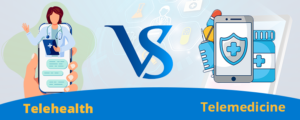Telehealth Use Cases: Chronic Disease to Sleep, How Virtual Care Heals
Telehealth use cases are the future of healthcare, through which doctors and other healthcare providers can now access our homes to offer their services. This implies that follow-up patient care for conditions such as diabetes, hypertension, or cardiovascular disease is equally easier today. Often, patients can talk to doctors, get some recommendations, and, in some cases, even get the prescription without ever stepping out of the house.
For instance, it is possible to use virtual consultations to provide customized recommendations and therapies for sleep disorders. Likewise, people with mental issues or requiring occasional check-ups can also get in touch with the concerned practitioners conveniently. Telehealth platforms mean that many appointments can be booked at more convenient times and do not require physical attendance, contributing to improving chronic and acute conditions management. In this article, you will get all the updates regarding chronic disease management and telehealth use cases.
Table of Contents
- 1. Telehealth Use Cases in Chronic Disease Management
- 2. Telehealth Use Cases in Mental Health Care
- 3. Telehealth Use Cases in Pediatric Care
- 4. Telehealth Use Cases in Geriatrics (Elderly Care)
- 5. Telehealth Use Cases in Women’s Health
- 6. Telehealth Use Cases in Dermatology
- 7. Telehealth Use Cases in Nutrition Counselling
- 8. Telehealth Use Cases in Rehabilitation/Post-Surgery Care
- 9. Telehealth Use Cases in Emergency Care
- 10. Telehealth Use Cases in Sleep Disorder
- Final Words
- Telehealth Use Cases: FAQs
1. Telehealth Use Cases in Chronic Disease Management
Managing chronic diseases management like diabetes, heart disease, and COPD can be challenging, but telehealth makes it easier. Through virtual visits, patients can get the care they need without leaving home.
- Telehealth allows for remote blood sugar monitoring and medication adjustments for diabetes management. Providers can view glucose readings to see how patients are responding to treatment and make changes to their meds or insulin doses as needed.
- For heart disease or high blood pressure, telehealth enables providers to monitor important vitals like blood pressure, heart rate, and weight. They can detect any concerning changes right away and adjust or switch medications to keep the condition stable.
- Telehealth offers virtual pulmonary rehab and education for COPD and other respiratory diseases. Patients can learn breathing exercises, stress management techniques, and more from the comfort of their homes.
2. Telehealth Use Cases in Mental Health Care
Telehealth is improving access to mental health care in huge ways. Telehealth for mental health care offers faster access to care, with many providers offering same-day or next-day appointments.
- Patients can have a video visit with their therapist on their schedule, even outside of normal business hours.
- Speaking to a therapist from the comfort of their home helps put patients at ease, especially when discussing sensitive issues.
- Continuity of care is enhanced. If patients relocate or travel, they can keep working with the same mental health professional through telehealth.
- Medication management is streamlined. The psychiatrist can prescribe and adjust medications remotely based on telehealth sessions and reported symptoms.
3. Telehealth Use Cases in Pediatric Care
For a parent, it can be stressful when the child isn’t feeling well. With telehealth Pediatric Care, parents can connect directly with a paediatrician via video chat for diagnosis and treatment. No more waiting for an appointment or taking time off school or work for frequent doctor trips
- A telehealth visit is ideal for minor illnesses like colds, ear infections, stomach bugs, or rashes. The doctor can examine the child over the video, determine if any tests or prescriptions are needed, and get the child on the road to recovery quickly.
- For chronic conditions like asthma, ADHD, or diabetes, telehealth provides a convenient way to monitor symptoms and make medication adjustments between in-person visits.
- Mental health care for conditions like anxiety, depression, or behavioural issues can also be provided remotely via telehealth. This may be an easier, more comfortable option for some children and teens.
Telehealth gives parents peace of mind that their children will get the care they need on time every time. Doctors can still physically examine patients when needed for more serious issues, but for many common pediatric conditions, a video visit is all that’s required. Telehealth brings the doctor to the parents
4. Telehealth Use Cases in Geriatrics (Elderly Care)
For elderly patients, telehealth platforms allow doctors to keep tabs on chronic conditions and overall health from a distance. Devices like blood pressure cuffs, pulse oximeters, and glucometers can automatically send readings to physicians so they can make sure levels stay in a healthy range and adjust medications as needed.
Telemedicine Elderly Care also enables doctors to examine patients through live video calls visually. They can check on things like:
- Mobility and range of motion: Watching patients walk, sit, stand, and move their limbs.
- Skin health: Look for any concerning moles, rashes, or wounds that need treatment.
- Cognitive ability: Engage in conversation to assess memory, reasoning, and judgment.
- Safety risks: Look for hazards in the home environment, such as clutter, poor lighting, or a lack of handrails, that could lead to falls or accidents.
- Mood and mental health: Speak with patients to determine if they seem depressed, anxious, or experiencing changes in behaviour or sleep.
5. Telehealth Use Cases in Women’s Health
Telehealth has become an invaluable tool in providing comprehensive and accessible healthcare services for women. With telehealth, women can access specialized care, seek consultations, and receive medical advice online. This advancement in telehealth for women has revolutionized how women can conveniently and efficiently access the healthcare they need. Here are some ways telehealth is transforming women’s healthcare:
- Reproductive Health: Women can consult with healthcare providers via video calls to discuss their reproductive goals, receive guidance on birth control options, and even seek assistance in managing fertility-related concerns.
- Prenatal and Postnatal Care: Expectant mothers can benefit greatly from telehealth services throughout their pregnancy journey. Telehealth enables regular check-ups and monitoring of maternal and fetal health. Postnatal telehealth care includes lactation support and guidance on newborn care.
- Menstrual Health and Gynecological Concerns: Women can discuss concerns such as irregular periods, painful menstruation, or symptoms of menopause with healthcare professionals via secure video calls.
- Breast Health: Telehealth Women’s Health is vital in breast cancer screening and follow-up care. Women can receive guidance on breast self-examination techniques and consult with healthcare providers regarding any concerns.
6. Telehealth Use Cases in Dermatology
Telehealth can be a game changer when it comes to skincare. It offers patients convenient access to skincare expertise. With Telemedicine Dermatology, individuals can receive guidance and treatment for various skin conditions. Through virtual appointments, dermatologists can visually examine the skin, evaluate symptoms, and provide personalized recommendations.
7. Telehealth Use Cases in Nutrition Counselling
Telehealth has made it easier for individuals to access expert guidance and support for their dietary needs and goals. With virtual consultations, nutritionists and dietitians can provide personalized counselling and create customized meal plans tailored to individual needs.
Through telehealth nutrition counselling, individuals can discuss their health concerns, dietary preferences, and goals with nutrition professionals. They can get advice on weight management, sports nutrition, and special dietary requirements.
Telehealth for nutrition counselling promotes regular communication and accountability, empowering individuals to make sustainable dietary changes and improve their overall health and well-being.
8. Telehealth Use Cases in Rehabilitation/Post-Surgery Care
Telemedicine rehabilitation and post-surgery care promote continuity of care, improve access to specialized expertise, and reduce the burden of travel. They empower patients to actively participate in their recovery process and facilitate a smoother transition from the hospital to home-based rehabilitation.
- Patients can connect with physical therapists, occupational therapists, or rehabilitation specialists via video calls to discuss their progress, symptoms, and goals.
- Patients can share videos of themselves performing exercises, and therapists can provide feedback and make necessary adjustments.
- Healthcare professionals can also address any concerns related to pain management, wound care, or adaptive equipment use.
9. Telehealth Use Cases in Emergency Care
Telehealth cannot replace the hands-on care provided in traditional emergency departments, But it offers valuable support, assessment, and guidance, especially in remote or underserved areas.
Patients who have received initial emergency treatment can have virtual visits to monitor their progress, discuss any lingering symptoms, or receive guidance on further medical care or rehabilitation.
While Telemedicine Emergency Care has its limitations, it is a valuable tool for remote assessment, triage, and guidance, enhancing access to healthcare during urgent situations. It should be used with traditional emergency care resources whenever possible for comprehensive and timely treatment.
10. Telehealth Use Cases in Sleep Disorder
With telehealth, sleep specialists can provide personalized treatment plans and ongoing support. They can recommend lifestyle modifications, sleep hygiene practices, and behavioural therapies to improve sleep quality. In some cases, they may prescribe medication and monitor its effectiveness remotely.
Follow-up appointments through telehealth allow for progress monitoring, adjustment of treatment plans, and addressing any concerns or challenges patients face. Telehealth platforms also facilitate the exchange of educational resources and tools to enhance sleep awareness and self-management.
Telemedicine sleep disorder care is convenient and efficient, reducing the need for travel and potential disruptions to sleep schedules. It empowers individuals to manage healthy sleep routines and improve overall well-being and quality of life.
Final Words
Telehealth has become a popular method in different sectors of healthcare and especially in chronic diseases and sleep disorders. This directly serves their needs of easy access to care with no transportation required, as well as ensuring a consistent and targeted approach to the treatment they receive. In diabetes management, treating mental health disorders, or attending to the needs of elderly patients, telehealth guarantees faster appointments. Through the use of virtual consultations, patients can be given medical advice and further care from the comfort of their own homes, which would prove to further improve their quality of life and health.
Telehealth Use Cases: FAQs
1. How does telehealth work?
Telehealth connects patients with healthcare providers through video calls or online platforms for remote medical consultations and care.
2. Is telehealth secure and private?
Yes, telehealth prioritizes security and privacy, with measures like encryption and compliance with data protection regulations such as HIPAA and GDPR.
3. Is telehealth costly?
Telehealth can be a cost-effective option, eliminating the need for travel expenses and reducing overall healthcare costs.
4. Do I need to buy any additional hardware?
In most cases, you don’t need to buy additional hardware. A smartphone, tablet, or computer with a webcam and internet connection is usually sufficient for telehealth consultations.
5. Will my insurance cover telehealth services?
Telehealth coverage varies by plan. Check with your insurance provider to confirm if telehealth is covered and inquire about any specific requirements or copayments.




